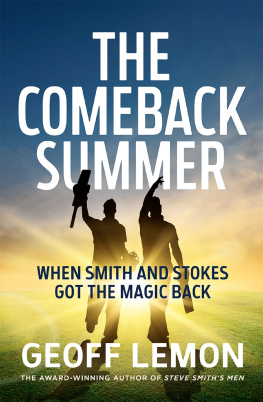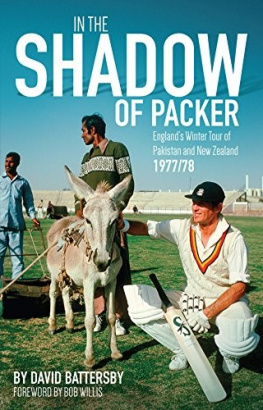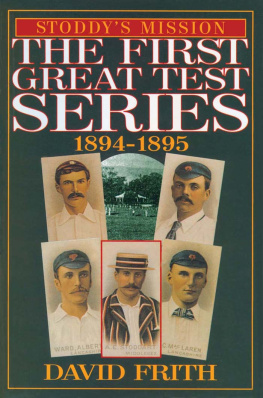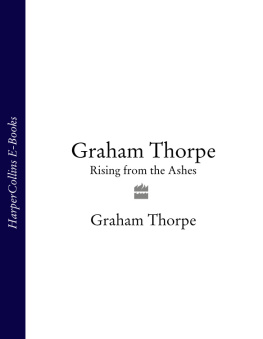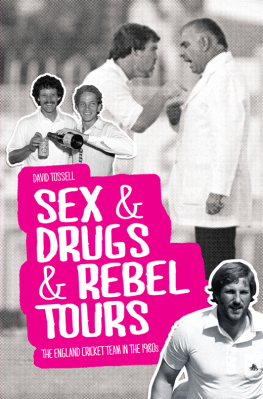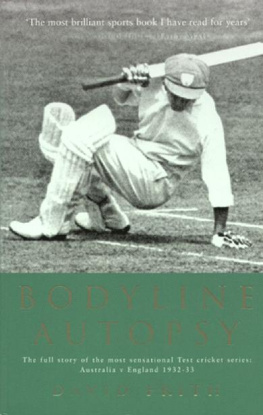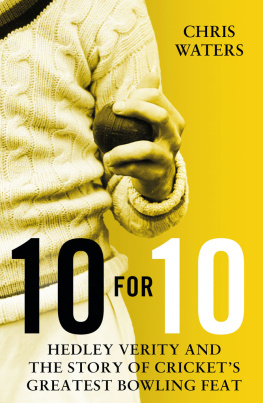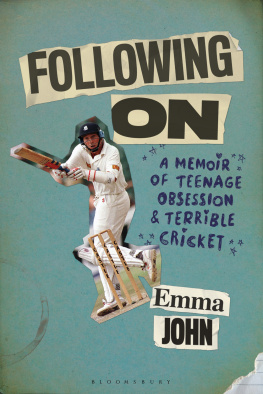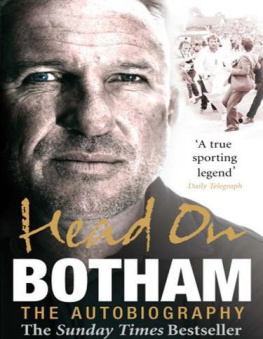500-1
THE MIRACLE OF HEADINGLEY 81
500-1 THE MIRACLE OF HEADINGLEY 81
Rob Steen & Alastair McLellan
Forewords by
MIKE BREARLEY & GIDEON HAIGH

Dedication
To Ian and Rupert that summer feelings going
to haunt us for the rest of our lives.
To my wonderful children, Laura, Josef and Evie,
and the fair Suzie all a boy could wish for.
First published by BBC Worldwide Ltd, 2001
This edition published in 2010 by John Wisden & Co.
An imprint of A&C Black Publishers Ltd
36 Soho Square, London W1D 3QY
www.wisden.com
www.acblack.com
Copyright Rob Steen and Alastair McLellan 2010
Wisden and its woodcut device
are registered trademarks of John Wisden & Co.
ISBN 978-1-4081-4085-7
All rights reserved. No part of this publication may be reproduced
in any form or by any means graphic, electronic or mechanical,
including photocopying, recording, taping or information storage or
retrieval systems without the prior permission of the publishers.
The right of the authors to be identified as the author
of this work has been asserted by them in accordance
with the Copyright, Designs and Patents Act, 1988.
A CIP catalogue record for this book is available from the British Library.
This book is produced using paper that is made from wood
grown in managed, sustainable forests. It is natural, renewable
and recyclable. The logging and manufacturing processes conform
to the environmental regulations of the country of origin.
Typeset in Sabon by seagulls.net
Printed and bound in Berkshire, England by Cox & Wyman
Picture credits: All photographs Patrick Eagar except the following:
Picture section page 1 (top) John Frost Newspapers; (bottom left) Corbis/
Bryn Cotton; (bottom right) PA News; page 3 (bottom) Hulton Getty.
All cover images Getty Images.
A book of this nature is nothing without its voices. Without the memories of the participants, the authors words would be mere bones. Heartfelt thanks are due, therefore, to (in batting order): Mike Brearley, Graham Gooch, Graeme Wood, John Dyson, David Gower, Graham Yallop, Dirk Wellham, Trevor Chappell, Peter Willey, John Emburey, Bob Taylor, Barrie Meyer, Chris Old, Ray Bright, Graham Dilley, Geoff Lawson and Peter Philpott.
We also owe a substantial debt to those who were intrinsic to the story of Headingley 81 despite never so much as muddying their boots, namely Trevor Bailey, Richie Benaud, Keith Boyce, Ted Corbett, Frank Crook, Bill Frindall, Pat Gibson, Christopher Martin-Jenkins, Brian Mossop, David Ryder, Mike Smith, Tony Smith and Steve Whiting. And to those who helped with nudges, winks, tip-offs and shoves in the general vicinity of the right direction: Rick Allen, Scyld Berry, Stan Dawson, Matthew Engel, Peter Hayter, Michael Henderson, Tim May, Kevin Mitchell, Brian Murgatroyd, Mark Ray, Martin Searby, David and Keith Summerfield, and Jim Woodward. And above all to Bob Harragan, whose hand-written transcription of the Test Match Special commentary made up handsomely for the absence of live television footage. We salute you all.
Merci beaucoup, too, to those who made this project possible: John Pawsey for accepting the pass and running with the ball; Ben Dunn at BBC Publications and Charlotte Atyeo at Wisden for having the wisdom and foresight to commission and reprint us; Rebecca Kincaid, Michele Savidge and Marian Thornley for their noble editing, and of course Patrick Eagar for his inimitable elegance with zoom lens and shutter.
Muchas gracias, finally, to all those who responded to our letter in Wisden Cricket Monthly by supplying their own reminiscences, however peripheral they may have felt. We sincerely hope that the editing process (impelled by the fact that we never suspected for a moment that we would get such marvellous feedback) meets with your approval. If a public event is defined by its witnesses, this is your story above all.
Alastair would like to thank his friends, family and those at 151 who helped in the research and writing of this book. He would particularly like to thank Rob for making the whole endeavour a pleasure and an education.
Rob would like to thank Anne, Laura, Josef, Evie, Woody and Kit for their love, support and patience. And, of course, Alastair, for demonstrating that great minds really can think alike and not come to blows.
Being asked to write a foreword to this book gives me, like other people, the chance to look back on the extraordinary series of the summer of 1981, and look also at the constructions I have settled for, the versions I have accepted through the rosy, yet dark, glasses of nostalgia.
One temptation is to view those events as having happened in the best of all possible worlds, as ultimately fitting, as strangely inevitable. It is even tempting to glaze the past in moral tinges to come to believe that all that happened was planned and deserved. Through these lenses, the Australians only got what they deserved, as did others of the players on this stage Ian Botham, Bob Willis, and also me. Such a view is often implied when the question has been asked, during Englands years of cricketing travail, what has happened to the spirits and triumphs of 81? as if there were any real doubt that those successes were earned fated outcomes of sporting right-mindedness, and hearts of stout oak.
Yet such were the margins, not only in the Headingley Test but in all three of Englands wins in the series, that the minutest chances, infinitessimal differences, could have overturned the outcomes. Then the story would have been of yet another bad-luck story, or of a team that didnt quite cut the mustard. In War and Peace, Tolstoy muses on the realities of historical explanation. One of his themes is how cut off from the chaotic, muddled realities of war are the neat battle plans of the generals. For want of a nail an empire is lost. For less than 1000 measly Florida votes a Presidency is lost. And cricket symbolises as acutely as any game the moments of luck, the turning points, on which ultimate success hinges an umpire sees or fails to see the slenderest edge; this umpire, at that moment, decrees that a particular delivery will indeed hit the stumps.
Yet Tolstoy overstates the case, or rather, as befits a man of his depth of thought, he modifies it. For as the book develops, we see as one of its main dramas the conflict between two styles of leadership, between the narcissistic, militaristic great man, as epitomised in Napoleon, and the homely, unglamourous, fat, ugly, peasant-like Russian general, Kutuzov. And Tolstoy makes it clear in his story that the Russian victory over Napoleon in 1812 would, ultimately, not have happened without the approach of Kutuzov, though what he offered was not adequately represented as battle strategy, or as the conscious planning of events. Unlike Napoleon, who cared only about himself and glory, Kutuzovs strengths lay rather in his deep understanding of, and feeling for, his people. His task was often to restrain the glory-seekers amongst his own officers, and the superficial and ambitious political pundits at home, from ill-conceived glory-trips and adventures. Kutuzov in his person transformed the Russian army. So according to Tolstoy the outcomes of history are not simply down to the unpredictable, momentary, intuitive movements of the massed individuals, but also lie in the leadership and management of morale.
Thoughts like these are alluring, too, when I review that 1981 series. Things are not all down to the vagaries of chance and the particular actions of individuals when they find themselves in the cauldron of conflict. Morale and strategies even the strategy of being suspicious of strategies also needs fostering, nurturing. I need not necessarily go along with Fred Truemans judgement at the end of the Headingley Test that Bothams performance came one match too late; that is, that it was simply chance that he happened on success in his first match after being relieved of, or relieving himself of, the captaincy.
Next page

